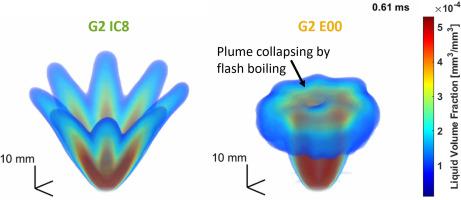当前位置:
X-MOL 学术
›
Int. J. Multiphase Flow
›
论文详情
Our official English website, www.x-mol.net, welcomes your feedback! (Note: you will need to create a separate account there.)
Spray process of multi-component gasoline surrogate fuel under ECN Spray G conditions
International Journal of Multiphase Flow ( IF 3.8 ) Pub Date : 2024-02-05 , DOI: 10.1016/j.ijmultiphaseflow.2024.104753 Joonsik Hwang , Ioannis K. Karathanassis , Phoevos Koukouvinis , Tuan Nguyen , Fabien Tagliante , Lyle M. Pickett , Brandon A. Sforzo , Christopher F. Powell
International Journal of Multiphase Flow ( IF 3.8 ) Pub Date : 2024-02-05 , DOI: 10.1016/j.ijmultiphaseflow.2024.104753 Joonsik Hwang , Ioannis K. Karathanassis , Phoevos Koukouvinis , Tuan Nguyen , Fabien Tagliante , Lyle M. Pickett , Brandon A. Sforzo , Christopher F. Powell

|
As modern gasoline direct injection (GDI) engines utilize sophisticated injection strategies, a detailed understanding of the air-fuel mixing process is crucial to further improvements in engine emission and fuel economy. In this study, a comprehensive evaluation of the spray process of single-component iso-octane (IC8) and multi-component gasoline surrogate E00 (36 % n-pentane, 46 % iso-octane, and 18 % n-undecane, by volume) fuels was conducted using an Engine Combustion Network (ECN) Spray G injector. High-speed extinction, schlieren, and microscopy imaging campaigns were carried out under engine-like ambient conditions in a spray vessel. Experimental results including liquid/vapor penetration, local liquid volume fraction, droplet size, and projected liquid film on the nozzle tip were compared under ECN G1 (573 K, 3.5 kg/m), G2 (333 K, 0.5 kg/m), and G3 (333 K, 1.01 kg/m) conditions. In addition to the experiments, preferential evaporation process of the E00 fuel was elucidated by Large–Eddy Simulations (LES). The three-dimensional liquid volume fraction measurement enabled by the computed tomographic reconstruction showed substantial plume collapse for E00 under the G2 and G3 conditions having wider plume growth and plume-to-plume interaction due to the fuel high vapor pressure. The CFD simulation of E00 showed an inhomogeneity in the way fuel components vaporized, with more volatile components carried downstream in the spray after the end of injection. The high vapor pressure of E00 also results in ∼4 μm smaller average droplet diameter than IC8, reflecting a higher rate of initial vaporization even though the final boiling point temperature is higher. Consistent with high vapor pressure, E00 had a wider plume cone angle and enhanced interaction with the wall to cover the entire surface of the nozzle tip in a film. However, the liquid fuel underwent faster evaporation, so the final projected tip wetting area was smaller than the IC8 under the flash-boiling condition.
中文翻译:

ECN Spray G条件下多元汽油替代燃料的喷雾工艺
由于现代汽油直喷 (GDI) 发动机采用复杂的喷射策略,因此详细了解空气燃料混合过程对于进一步改善发动机排放和燃油经济性至关重要。在本研究中,对单组分异辛烷 (IC8) 和多组分汽油替代品 E00(按体积计 36% 正戊烷、46% 异辛烷和 18% 正十一烷)的喷雾过程进行了综合评估) 燃料是使用发动机燃烧网络 (ECN) Spray G 喷射器进行的。高速消光、纹影和显微镜成像活动是在喷雾容器中类似发动机的环境条件下进行的。在ECN G1(573 K,3.5 kg/m)、G2(333 K,0.5 kg/m)、和 G3(333 K,1.01 kg/m)条件。除了实验之外,E00 燃料的优先蒸发过程还通过大涡模拟 (LES) 进行了阐明。通过计算机断层扫描重建实现的三维液体体积分数测量显示,在 G2 和 G3 条件下,E00 的羽流大量塌陷,由于燃料高蒸气压,具有更宽的羽流生长和羽流与羽流相互作用。 E00 的 CFD 模拟显示燃料成分汽化方式不均匀,喷射结束后更多的挥发性成分被带到喷雾下游。 E00 的高蒸气压还导致平均液滴直径比 IC8 小约 4 μm,这反映出即使最终沸点温度较高,初始汽化速率也较高。与高蒸气压一致,E00 具有更宽的羽流锥角,并增强与壁的相互作用,以薄膜覆盖喷嘴尖端的整个表面。然而,液体燃料蒸发得更快,因此最终预计的尖端润湿面积小于闪蒸条件下的IC8。
更新日期:2024-02-05
中文翻译:

ECN Spray G条件下多元汽油替代燃料的喷雾工艺
由于现代汽油直喷 (GDI) 发动机采用复杂的喷射策略,因此详细了解空气燃料混合过程对于进一步改善发动机排放和燃油经济性至关重要。在本研究中,对单组分异辛烷 (IC8) 和多组分汽油替代品 E00(按体积计 36% 正戊烷、46% 异辛烷和 18% 正十一烷)的喷雾过程进行了综合评估) 燃料是使用发动机燃烧网络 (ECN) Spray G 喷射器进行的。高速消光、纹影和显微镜成像活动是在喷雾容器中类似发动机的环境条件下进行的。在ECN G1(573 K,3.5 kg/m)、G2(333 K,0.5 kg/m)、和 G3(333 K,1.01 kg/m)条件。除了实验之外,E00 燃料的优先蒸发过程还通过大涡模拟 (LES) 进行了阐明。通过计算机断层扫描重建实现的三维液体体积分数测量显示,在 G2 和 G3 条件下,E00 的羽流大量塌陷,由于燃料高蒸气压,具有更宽的羽流生长和羽流与羽流相互作用。 E00 的 CFD 模拟显示燃料成分汽化方式不均匀,喷射结束后更多的挥发性成分被带到喷雾下游。 E00 的高蒸气压还导致平均液滴直径比 IC8 小约 4 μm,这反映出即使最终沸点温度较高,初始汽化速率也较高。与高蒸气压一致,E00 具有更宽的羽流锥角,并增强与壁的相互作用,以薄膜覆盖喷嘴尖端的整个表面。然而,液体燃料蒸发得更快,因此最终预计的尖端润湿面积小于闪蒸条件下的IC8。



























 京公网安备 11010802027423号
京公网安备 11010802027423号